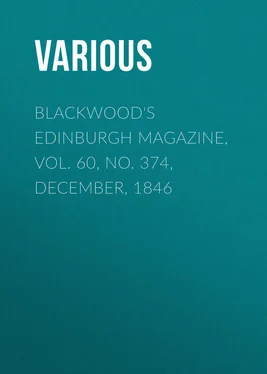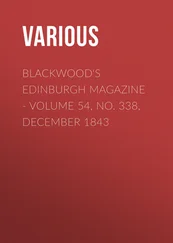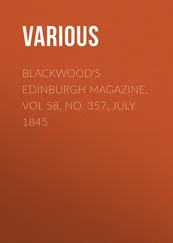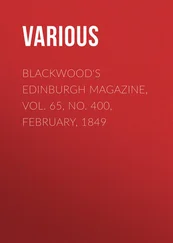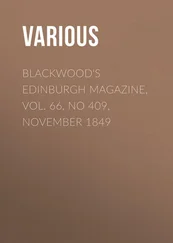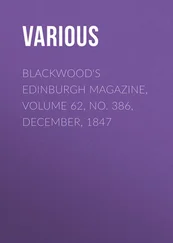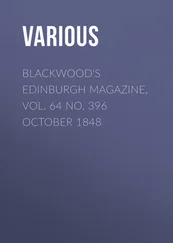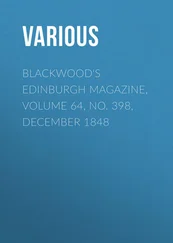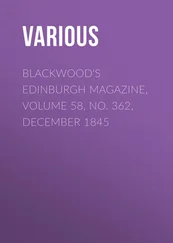Various - Blackwood's Edinburgh Magazine, Vol. 60, No. 374, December, 1846
Здесь есть возможность читать онлайн «Various - Blackwood's Edinburgh Magazine, Vol. 60, No. 374, December, 1846» — ознакомительный отрывок электронной книги совершенно бесплатно, а после прочтения отрывка купить полную версию. В некоторых случаях можно слушать аудио, скачать через торрент в формате fb2 и присутствует краткое содержание. Издательство: Иностранный паблик, Жанр: periodic, foreign_edu, Путешествия и география, на английском языке. Описание произведения, (предисловие) а так же отзывы посетителей доступны на портале библиотеки ЛибКат.
- Название:Blackwood's Edinburgh Magazine, Vol. 60, No. 374, December, 1846
- Автор:
- Издательство:Иностранный паблик
- Жанр:
- Год:неизвестен
- ISBN:нет данных
- Рейтинг книги:4 / 5. Голосов: 1
-
Избранное:Добавить в избранное
- Отзывы:
-
Ваша оценка:
- 80
- 1
- 2
- 3
- 4
- 5
Blackwood's Edinburgh Magazine, Vol. 60, No. 374, December, 1846: краткое содержание, описание и аннотация
Предлагаем к чтению аннотацию, описание, краткое содержание или предисловие (зависит от того, что написал сам автор книги «Blackwood's Edinburgh Magazine, Vol. 60, No. 374, December, 1846»). Если вы не нашли необходимую информацию о книге — напишите в комментариях, мы постараемся отыскать её.
Blackwood's Edinburgh Magazine, Vol. 60, No. 374, December, 1846 — читать онлайн ознакомительный отрывок
Ниже представлен текст книги, разбитый по страницам. Система сохранения места последней прочитанной страницы, позволяет с удобством читать онлайн бесплатно книгу «Blackwood's Edinburgh Magazine, Vol. 60, No. 374, December, 1846», без необходимости каждый раз заново искать на чём Вы остановились. Поставьте закладку, и сможете в любой момент перейти на страницу, на которой закончили чтение.
Интервал:
Закладка:
West and East would have been no inappropriate title for Mr Smith's twin volumes. In the first, he keeps on the Court side of Temple Bar; the second he devotes to the City. As may be supposed, the former is the more sprightly and piquant chronicle; but the latter does not yield to it in striking records and interesting historical facts. Let us accompany the antiquarian on his first ramble, from Hyde Park Corner to Charing Cross, starting from Apsley House, of which, although scarcely included in the design of his work, as announced on the title-page, he gives, as of various other modern buildings, a concise account.
How few individuals of the human tide that daily flows and ebbs along Piccadilly are aware, that within a century that aristocratic quarter was a most disreputable outlet from London. The ground now covered with ranges of palaces, the snug and select district of May Fair, dear to opulent dowagers and luxurious célibataires , was occupied, but a short hundred years since, by a few detached dwellings in extensive gardens, and by a far larger number of low taverns. Some of these, as the White Horse and Half Moon, have given their names to the streets to which their bowling-greens and skittle-alleys tardily gave way. The Sunday excursions of the lower orders were then more circumscribed than at present; and these Piccadilly publics were much resorted to on the Sabbath, in the manner of a country excursion; for Piccadilly was then the country. "Among the advertisements of sales by auction in the original edition of the Spectator , in folio, published in 1711, the mansion of Streater, jun., is advertised as his country house , being near Bolton Row, in Piccadilly; his town residence was in Gerrard Street, Soho." The taverns nearest to Hyde Park were chiefly patronised by the soldiers, particularly, we are informed, on review days, when they sat in rows upon wooden benches, placed in the street for their accommodation, combing, soaping, and powdering each other's hair. The bad character of the neighbourhood, and perhaps, also, the nuisance of May Fair, which lasted for fifteen days, and was not abolished till 1708, prevented the ground from increasing in value; and accordingly we find that Mr Shepherd, after whom Shepherd's Market was named, offered for sale, as late as the year 1750, his freehold mansion in Curzon Street, and its adjacent gardens, for five hundred pounds. At that price it was subsequently sold. Houses there were, however, in the then despised neighbourhood of Piccadilly, of high value; but it arose from their intrinsic magnificence, which counterbalanced the disadvantages of situation. Evelyn mentions having visited Lord John Berkeley at his stately new house, which was said to have cost thirty thousand pounds, and had a cedar staircase. He greatly commends the gardens, and says that he advised the planting of certain holly-hedges on the terrace. Stratton Street was built on the Berkeley estate, and so named in compliment to the Stratton line of that family. At what is now the south end of Albemarle Street, stood Clarendon House, built, as Bishop Burnet tells us, on a piece of ground granted to Lord Clarendon by Charles II. The Earl wished to have a plain ordinary house, but those he employed preferred erecting a palace, whose total cost amounted to fifty thousand pounds.
"During the war," says the Bishop, "and in the plague year, he had about three hundred men at work, which he thought would have been an acceptable thing, when so many men were kept at work, and so much money, as was duly paid, circulated about. But it had a contrary effect: it raised a great outcry against him." The sale of Dunkirk to the French for four hundred thousand pounds, had taken place only three years before, and was still fresh in men's minds. The odium of this transaction fell chiefly on Lord Clarendon, who was accused of pocketing a share of its profits; and the people gave the name of Dunkirk House to his new mansion. Others called it Holland House, thereby insinuating that it was built with bribes received from the Dutch, with whom this country then waged a disastrous war. In spite of popular outcry, however, the house was completed in 1667, the year of Clarendon's disgrace and banishment. Fifteen years later, after his death, his heir sold the place to the Duke of Albemarle for twenty-five thousand pounds, just half what it cost; and the Duke parted with it for ten thousand more. Finally, it was pulled down to make room for Albemarle and Stafford Streets; of which latter, as appears from old plans of London, the centre of Clarendon House occupied the entire site.
Piccadilly was formerly the headquarters of the makers of leaden figures. The first yard for this worthless description of statues was founded by John Van Nost, one of the numerous train of Dutchmen who followed William III. to England. His establishment soon had imitators and rivals; and, in 1740, there were four of these figure-yards in Piccadilly, all driving a flourishing trade in their leaden lumber. The statues were as large as life, and often painted. "They consisted of Punch, Harlequin, Columbine, and other pantomimical characters; mowers whetting their scythes, haymakers resting on their rakes, gamekeepers in the act of shooting, and Roman
Конец ознакомительного фрагмента.
Текст предоставлен ООО «ЛитРес».
Прочитайте эту книгу целиком, купив полную легальную версию на ЛитРес.
Безопасно оплатить книгу можно банковской картой Visa, MasterCard, Maestro, со счета мобильного телефона, с платежного терминала, в салоне МТС или Связной, через PayPal, WebMoney, Яндекс.Деньги, QIWI Кошелек, бонусными картами или другим удобным Вам способом.
1
Mr Kohl fixes the date of the "melted lead" day at 1319, forgetting that Margaret, the Semiramis of the North, in whose reign the event occurred, did not reign in Denmark until about 1375. She died in 1412.
2
In the year 1660, the different estates of Denmark made a voluntary surrender of their rights into the hands of their sovereign, who became by that act absolute : it is a fact unparalleled in the history of any other country. Up to the year 1834, this unlimited power was exercised by the kings, who, it must be said to their honour, never abused it by seeking to oppress or enslave their subjects. In the year 1834, however, Frederic VI., of his own free will and choice, established a representative government. The gift was by no means conferred in consequence of any discontent exhibited under the hitherto restrictive system. The intentions of the monarch were highly praiseworthy; their wisdom is not so clear, as, under the new law, the kingdom is divided into four parts – 1. The Islands; 2. Sleswig; 3. Jutland; 4. Holstein; each having its own provincial assembly. The number of representatives for the whole country amounts to 1217. Each representative receives four rix-dollars a-day (a rix-dollar is 2s. 21⁄2d.) for his services, besides his travelling expenses. The communication between the sovereign and the assembly is through a royal commissioner, who is allowed to vote, but not to speak. – See Wheaton's History of Scandinavia .
3
Whilst in this neighbourhood, Mr Kohl should have explored the Gunderler Wood, where stone circles and earth mounds are yet carefully preserved, marking the site of one of the principal places of sacrifice in heathen times. At Gysselfelt , a lay nunnery exists, founded as recently as the year 1799.
Интервал:
Закладка:
Похожие книги на «Blackwood's Edinburgh Magazine, Vol. 60, No. 374, December, 1846»
Представляем Вашему вниманию похожие книги на «Blackwood's Edinburgh Magazine, Vol. 60, No. 374, December, 1846» списком для выбора. Мы отобрали схожую по названию и смыслу литературу в надежде предоставить читателям больше вариантов отыскать новые, интересные, ещё непрочитанные произведения.
Обсуждение, отзывы о книге «Blackwood's Edinburgh Magazine, Vol. 60, No. 374, December, 1846» и просто собственные мнения читателей. Оставьте ваши комментарии, напишите, что Вы думаете о произведении, его смысле или главных героях. Укажите что конкретно понравилось, а что нет, и почему Вы так считаете.
